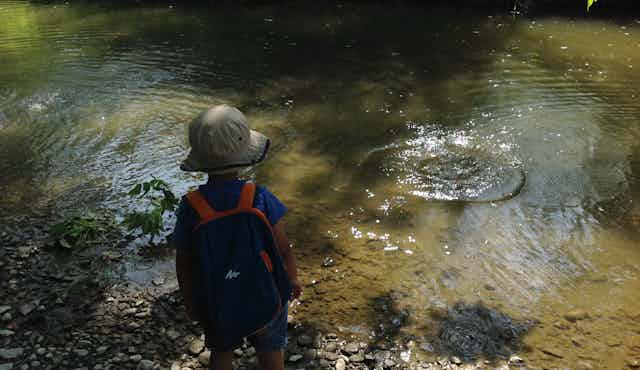In the Anishinaabe teachings, Nibi (water) is the blood of Aki (Earth), the giver of life — a sacred energy that is part of us, flowing within and between us.
Children want to be with water, learn from water and watery places and return to water.
In mainstream early childhood programs, classrooms may have a water table that provides opportunities for children’s sensory water play and learning. In The Willows, a land-based early childhood program at Humber College in the northwest end of Toronto, engaging with water is extended outdoors — in forests and meadows, by the wetlands, ponds and GabeKanang Ziibi (the Humber River).

On the traditional and treaty lands of the Mississaugas of the Credit, young children interact with water through the seasons and in all weather. Playing in the rain offers new experiences and perspectives; water is also a gift for the trees, birds and the river.
Lynn, one of the authors of this story, shares Anishinaabe teachings and stories from Onaubinosay Elder Jim Dumont and regularly walks with children on the land. Jim teaches that water is medicine.
Water on the Land
Children are drawn to stick and water play. They throw stones back to the water, jump in puddles.

They notice turtles on logs, investigate velvety green mosses revived by spring rains and make up stories about muddy animal tracks.
They like drinking wild peppermint tea outdoors, collect water for the vegetable garden and say that water nestled in flower petals are the drinking cups for bees and birds. The children walk with GabeKanang Ziibi flowing alongside the forest trails.
These relationships help children read the stories of what water is teaching them.
Historically, GabeKanang Ziibi and the Humber River watershed provided the connection between Lake Ontario and the Lake Simcoe/Georgian Bay regions for the Anishinaabe, the Haudenosaunee and the Wendat peoples.

This territory is also subject to The Dish With One Spoon Treaty, an agreement between Anishinaabeg, Haudenosaunee, Wendat peoples and allied nations. It ensures the right to take from the land, linked to a responsibility to leave enough for current and future generations and allow nature time to regenerate.
Land as teacher

In seeing land as a teacher that supports respectful, relational, reciprocal and responsible engagements, children learn about relationships with Neekaanagana (All Our Relations), like land, water, animals, plant life and other beings that human beings depend upon for survival.
We learn the ways of the ones who take care of us, so we may take care of them.
With Indigenous knowledge holders and storytellers, we walk together and learn that each element, plant and animal not only has a name but a spirit, a story, a gift and a responsibility, as do we humans.
At the medicine teaching garden, children experience the teachings of the Four Directions — kindness, sharing, honesty and strength. The children smell the calming scent of the rain-soaked spirit of Wiingashk (sweetgrass) that represents kindness. They learn to respect the spirit of Asin (rocks) that encircle and shelter the garden by not climbing on them.
Nature is not just seen as resource or commodity, but something that engages mind, body, heart and spirit together.

Increasing practice and research in the field of early childhood and outdoor play integrates both Indigenous and Western and non-Indigenous worldviews and knowledges. Etuaptmumk (in the Mi’kmaw language), or two-eyed seeing, embraces multiple ways of knowing, being and doing.
Read more: Nature stories: Children experience the seasons with Indigenous knowledge keepers
Supporting young children’s daily experiences and ethical connections to place with engaged adult mentors contributes to a life-long kinship to the land.
Memories of Nibi

The Willows program aims to build community relationships with people involved in Indigenous cultural networks and early childhood education.
Joanne, one of the authors of this story who our program has connected with, remembers Nibi growing up in the Georgian Bay Area. She remembers toes in the pebbled stream, chasing fish into a reclaimed net, cooked over a driftwood fire by mom and eaten on the beach. She recalls growing up without running water and carrying spring water home, drinking from the creeks during play-filled days and running free through the bush along the creeks and down the shores of Georgian Bay. Joanne says:
“Being respectful of and having respect for water is important. Experiencing and connecting to water in its natural environment is essential for children to develop confidence, master skill and overcome fear. Building a healthy relationship not only with the environment, but with all those who call the land home is crucial as those resources sustain us.”
On a visit to the Humber Arboretum, Joanne teaches us the word “Biimishodisii” (snail in Anishinaabemowin).
Restoring relationships

In acknowledging nature as teacher, in our early childhood program, we ask ourselves what we can do to honour our relationships that allow all of Earth’s creations to live in harmony and balance.
We read Nibi Emosaawdang (The Water Walker) about Anishinaabe Elder and Nokomis (grandmother) Josephine Ba-Mandamin who walked to protect the waters of the Earth.
We share and draw stories about the water.
In celebration of Earth Day, April 22, and as people who have received the gift of land and its resources, we hold the capacity and the responsibility to lead by example in all that we do.
(Re)connecting to land and water is a sensory balm we need, the seeds of hope and resilience through activities like planting a garden, embracing rain or reading and sharing knowledge. What will you do?
“We must learn to flow like the river because healthy water moves freely.” — Nokomis Josephine Mandamin

